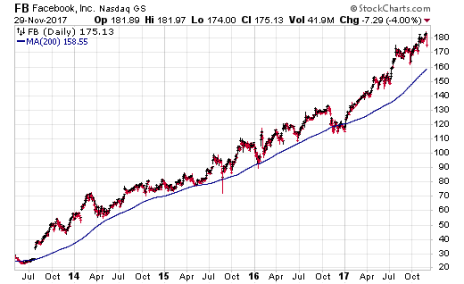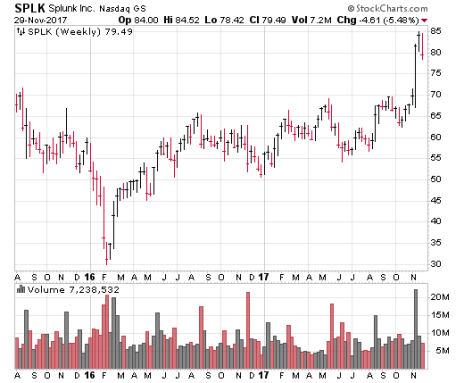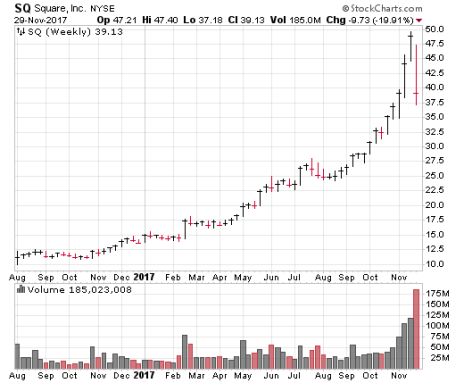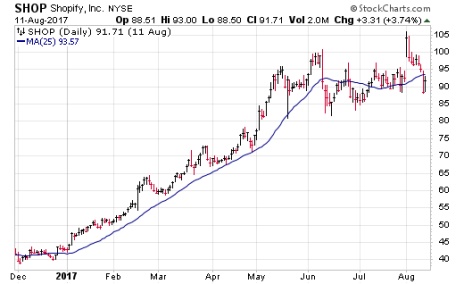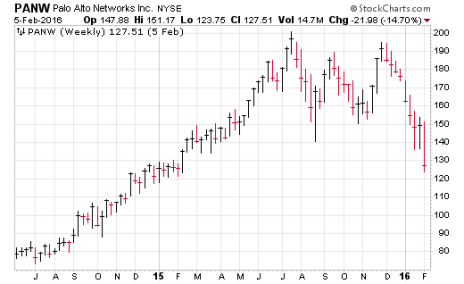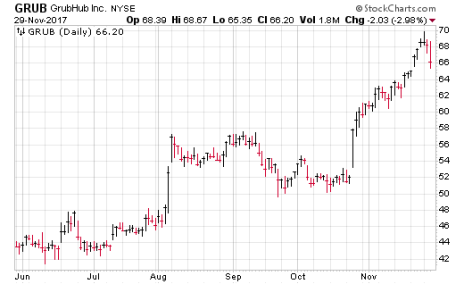18 ½ years at Cabot have taught me that if there’s one thing that subscribers (professional, experienced, or novice) want help with, it’s tactics for selling winning stocks.
While it’s not easy, buying stocks isn’t as hard as many investors make it out to be, especially in a bull market—it’s not that hard to find a stock with a great story and excellent growth numbers and, with some experience, to find a lower-risk entry point.
And, once you have the discipline to cut all losses short in growth stocks, getting rid of your losers and laggards is mostly automatic.
But what do you do when you catch a tiger by the tail? How do you know when to sell when you have a good profit?
That’s the riddle that many investors are dealing with now. It’s been a great year (Cabot Growth Investor’s Model Portfolio is up more than 35%!) and I know most of you have solid gains in many stocks despite the sharp drop this week in many growth stocks. Now, the question I’m hearing more and more is when to bail out.
That’s what my Daily today is about—below are 10 of the soundest rules, tools and principles for selling winning stocks. The first few will be general ideas, and I’ll drill down to some more specific things to look for that tell you a top could be coming soon.
- First off, let’s start with a fact: You’re either going to sell early (before the top) or late (after the top). So don’t agonize over pinpointing a stock’s exact high—it’s not going to happen. A better use of your time is to determine what kind of investor you are, i.e., whether you’d prefer to get out on the way up but leave some potential profits on the table (sell early), or whether you’d rather squeeze out all you can from a stock but give some profits back at the end (sell late).
- For growth investors, you can mix both these approaches. I personally like to sell some on the way up (sometimes, if the stock is a very big winner, I might sell two or three batches for partial profits), and then sell my remaining chunk on the way down. The reason why I always let the last piece run is that you just never know if the stock you own could just keep running, sometimes for years—I thought Facebook (FB) was cooked a few times since I originally bought it in Cabot Growth Investor in July 2013, but it’s held above its long-term 200-day line (give or take) ever since, allowing us to ride it out.
- Also, when selling, focus on the chart and not the fundamentals—the company, in other words, is not the stock. The most common question I get when a very strong stock hits the skids is “Isn’t the company still doing fine?” Well, sure, but did the company improve its intrinsic value by 150% (or whatever the stock’s run was) during the prior few months? No! The two are linked, of course, but the stock is the stock and the company is the company. Moreover, the stock will usually top out months before the fundamentals do, so if you wait for obvious bad news, you’ll usually be very late.
- Getting into more specific rules/tools, one thing you want to be aware of is climax action—generally defined as a 20%-plus surge over a two-to-three-week span. But realize there’s a big difference between a blastoff (a big surge coming out of a huge consolidation) and a climax run (a big move after many months of a big advance).
- For example, let’s look at two stocks. The first is Splunk (SPLK), a Big Data software firm that reported earnings two weeks ago. Notice how the stock exploded higher after the report and rallied higher a couple of days later—all in all, SPLK rallied 20% in just three days! This was a buyable earnings gap, as SPLK was just emerging from a giant two-year consolidation.
- On the flip side, there’s Square (SQ), which also had a big run recently, rallying a bit more than 30% during the past two weeks before Monday’s plunge. However, prior to this rally, the stock had enjoyed a monster move, rallying from a breakout point near 16 in February (and even more from its mid-2016 low near 9!). Combined with the recent downdraft, the action raises the odds of an intermediate-term top and is probably a good reason to at least sell some of your shares.
6a. A handy way to quantify this is when a stock (a) has been running for at least five or six months without a significant correction, and (b) the stock is at least 70% (for a big-cap leader) to 100% (for a small/mid-cap leader) above its 200-day moving average.
- Of course, part of the selling decision is knowing when NOT to sell, and I can say that when you have a chart like SPLK—a big base, and a huge breakout—you want to force yourself not to take profits early unless something really goes haywire (like the market falling apart). The first pullbacks after such moves, in fact, are usually buyable. So if you own some, hang on, and if you don’t, you could try to grab some shares on that first dip.
- Another thing to look for is when a stock has respected a similar moving average for at least five or six weeks in a row, and then breaks it—such a scenario usually marks an intermediate-term top. A good example is Shopify (SHOP) earlier this year—notice how, from its breakout in January through early June, the stock never fell below its 25-day line. Then, when it finally broke it in June, it marked a change of character (though not necessarily a major top). Taking partial profits on such a break often makes sense; in SHOP’s case, the stock didn’t really get going for another two and a half months.
- When I catch a really big, longer-term winner in a big, liquid growth stock, I will almost always hold a piece of it down to the 200-day moving average. Doing this with “glamour” stocks that really blow off can be tricky, but when you’re talking about, say, Facebook (FB) during the past few years, Baidu (BIDU) back in 2009-2011 or Alibaba (BABA) today, you’re usually better off giving the stock a lot of rope, as big winners can often trend for years. Remember, the big money is in the big swing.
- Last, but not least, not all stocks will top out with a bang on the upside or downside. Many times, a top will form via churning, which occurs when, after a good-sized run, the stock chops around over many weeks (lots of movement but no real price progress). You’ll also often see the stock’s relative performance (RP) line stall out as well. A good example of this is Palo Alto Networks (PANW) back in late 2015—after a smooth run for many months, look at how the stock thrashed around for a few months and couldn’t tighten up. Eventually, it gave up the ghost and is still working on recovering (despite greatly increased sales and earnings during the past two years!).
Of course, it’s still a bull market, so I’m not trying to worry you; I’m still thinking the uptrend has a way to go. But there are some stocks that have been running for many months and are beginning to show toppy action, so you ideally want to have your antennae up, take action when you see it, and move money into fresher leading stocks.
Like what, you ask? Well, Splunk (SPLK), mentioned above, is one example. And another is Grubhub (GRUB), which, in my view, only got going in late October when the stock gapped up nicely on earnings. The stock seems to have changed character after years of herky-jerky action, as fears of competition have faded due to the company’s dominant position (it’s four times the size of its closest competitor) and excellent execution.
Like all growth stocks, GRUB got hit this week, but this looks like a normal shakeout to me given its recent liftoff. Of course, further dips are possible if growth stocks continue to retreat, but I’m not opposed to buying some shares around here.
